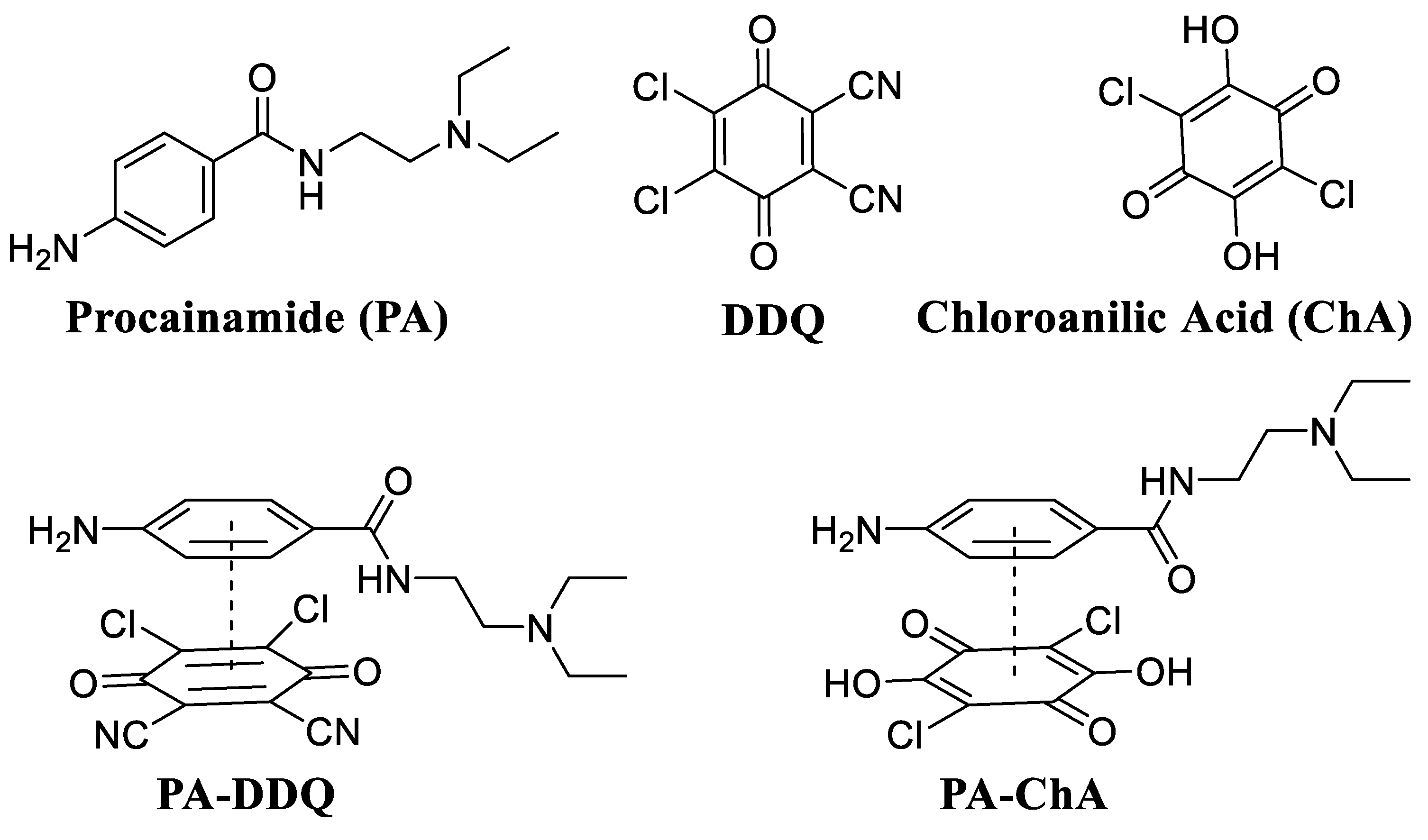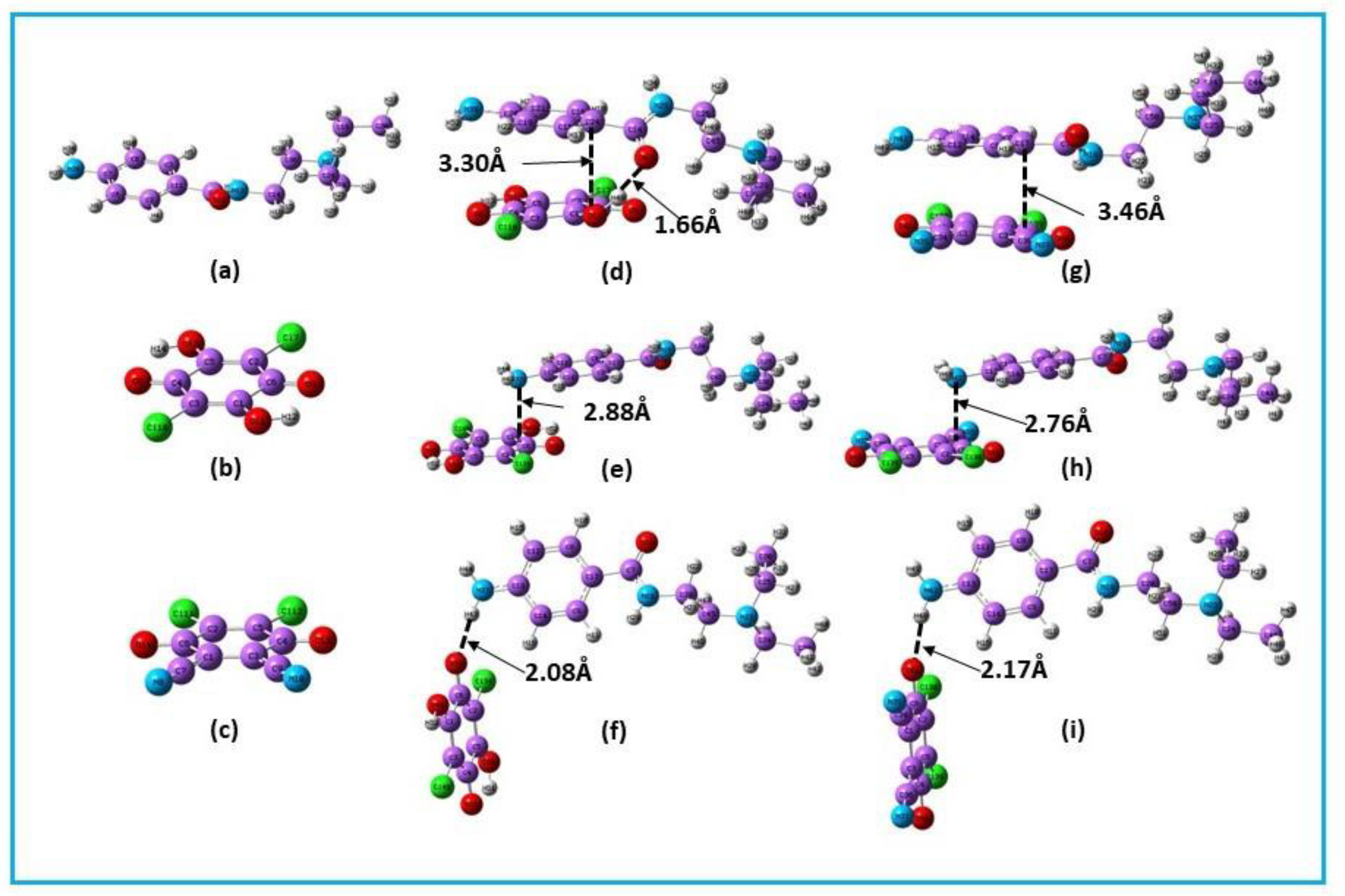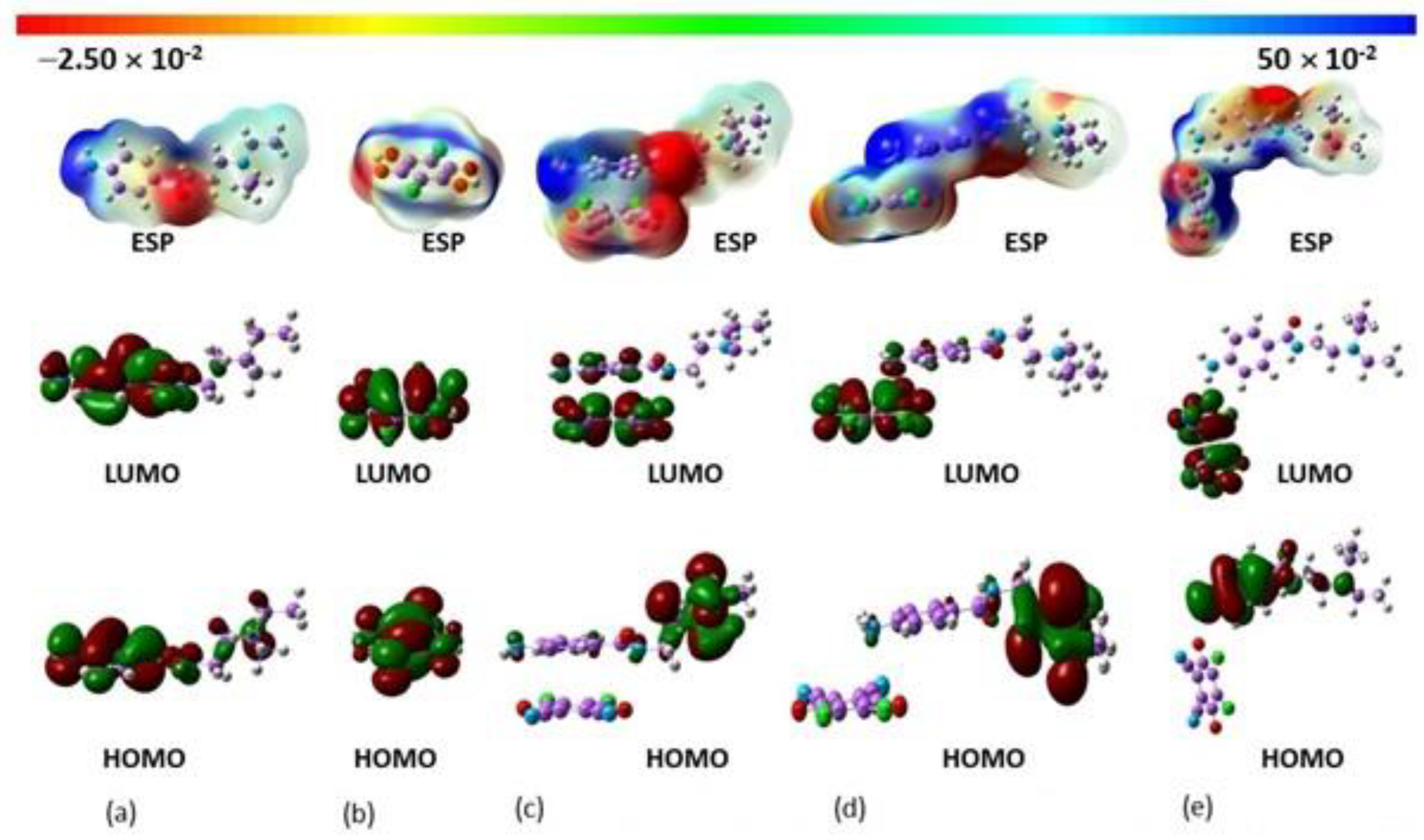Procainamide Charge Transfer Complexes with Chloranilic Acid and 2,3-Dichloro-5,6-dicyano-1,4-benzoquinone: Experimental and Theoretical Study
Abstract
1. Introduction
2. Experimental Section
2.1. General
2.2. Synthesis of CT Complexes PA-ChA and PA-DDQ
2.2.1. Preparation of PA-ChA Complex
2.2.2. Preparation of PA-DDQ Complex
2.3. Stoichiometry
2.4. Formation Constant
2.5. Spectroscopic Physical Parameters
2.5.1. Oscillator Strength (f) Transition Dipole Moment (−µe)
2.5.2. Ionization Potential (IP)
2.5.3. Energy of the CT Complexes (ECT)
2.5.4. Resonance Energy (RN)
2.5.5. Dissociation Energy (W) (eV)
2.5.6. Gibbs Free Energy Change (ΔG°)
2.6. DFT Calculations
3. Results and Discussion
3.1. Synthesis of CT Complexes PA-ChA and PA-DDQ
3.2. Electronic Absorption Spectra
3.3. Molecular Composition of the PA Complexes
3.4. Formation Constant
3.5. Spectroscopic Physical Parameters
3.5.1. Oscillator Strength (f) Transition Dipole Moment (Debye)
3.5.2. Ionization Potential (IP)
3.5.3. Energy of the CT Complexes (ECT)
3.5.4. Resonance Energy (RN)
3.5.5. Dissociation Energy (W)
3.5.6. Gibbs Free Energy Change (ΔG°)
3.6. Spectroscopy
3.6.1. Infrared (IR) Spectra
IR Spectra of PA-ChA Complex
IR Spectra of PA-DDQ Complex
3.6.2. NMR Spectra
NMR Spectra of PA-ChA Complex
NMR Spectra of PA-DDQ Complex
3.7. DFT/TD-DFT Calculations
3.7.1. Optimized Geometrical Structures
3.7.2. HOMO–LUMO Analysis
Electronegativity
Chemical Potential
Electrophilicity Index
3.7.3. Theoretical Electronic Absorption Spectra
4. Conclusions
Supplementary Materials
Author Contributions
Funding
Institutional Review Board Statement
Informed Consent Statement
Data Availability Statement
Acknowledgments
Conflicts of Interest
References
- Mian, M.S.; El-Obeid, H.A.; Al-Badr, A.A. Procainamide Hydrochloride. In Analytical Profiles of Drug Substances and Excipients; Brittain, H.G., Ed.; Academic Press: Cambridge, MA, USA, 2001; Volume 28, pp. 251–332. [Google Scholar]
- Zamponi, G.W.; Sui, X.; Codding, P.W.; French, R.J. Dual actions of procainamide on batrachotoxin-activated sodium channels: Open channel block and prevention of inactivation. Biophys. J. 1993, 65, 2324–2334. [Google Scholar] [CrossRef]
- Shen, D.; Chen, W.-C.; Lo, M.-F.; Lee, C.-S. Charge-transfer complexes and their applications in optoelectronic devices. Mater. Today Energy 2021, 20, 100644. [Google Scholar] [CrossRef]
- Adam, A.M.A. Application of charge-transfer complexation for evaluation of the drug-receptor mechanism of interaction: Spectroscopic and structure morphological properties of procaine and pilocarpine complexes with chloranilic acid acceptor. Russ. J. Gen. Chem. 2014, 84, 1225–1236. [Google Scholar] [CrossRef]
- Adam, A.M.A. Nano-structured complexes of reserpine and quinidine drugs with chloranilic acid based on intermolecular H-bond: Spectral and surface morphology studies. Spectrochim. Acta A Mol. Biomol. Spectrosc. 2014, 127, 107–114. [Google Scholar] [CrossRef]
- Wang, W.; Luo, L.; Sheng, P.; Zhang, J.; Zhang, Q. Multifunctional Features of Organic Charge-Transfer Complexes: Advances and Perspectives. Chem. A Eur. J. 2021, 27, 464–490. [Google Scholar] [CrossRef]
- Zhu, L.; Yi, Y.; Fonari, A.; Corbin, N.S.; Coropceanu, V.; Brédas, J.-L. Electronic Properties of Mixed-Stack Organic Charge-Transfer Crystals. J. Phys. Chem. C 2014, 118, 14150–14156. [Google Scholar] [CrossRef]
- McGuire, M.A. Crystal and Magnetic Structures in Layered, Transition Metal Dihalides and Trihalides. Crystals 2017, 7, 121. [Google Scholar] [CrossRef]
- Khan, I.M.; Islam, M.; Shakya, S.; Alam, K.; Alam, N.; Shahid, M. Synthesis, characterization, antimicrobial and DNA binding properties of an organic charge transfer complex obtained from pyrazole and chloranilic acid. Bioorganic. Chem. 2020, 99, 103779. [Google Scholar] [CrossRef]
- Karmakar, A.; Bandyopadhyay, P.; Mandal, N. Synthesis, spectroscopic, theoretical and antimicrobial studies on molecular charge-transfer complex of 4-(2-thiazolylazo)resorcinol (TAR) with 3, 5-dinitrosalicylic acid, picric acid, and chloranilic acid. J. Mol. Liq. 2019, 299, 112217. [Google Scholar] [CrossRef]
- Singh, N.; Khan, I.M.; Ahmad, A.; Javed, S. Synthesis, crystallographic and spectrophotometric studies of charge transfer complex formed between 2,2′-bipyridine and 3,5-dinitrosalicylic acid. J. Mol. Liq. 2014, 191, 142–150. [Google Scholar] [CrossRef]
- Refat, M.S.; Saad, H.A.; Adam, A.M. Spectral, thermal and kinetic studies of charge-transfer complexes formed between the highly effective antibiotic drug metronidazole and two types of acceptors: σ- and π-acceptors. Spectrochim. Acta A Mol. Biomol. Spectrosc 2015, 141, 202–210. [Google Scholar] [CrossRef]
- Nampally, V.; Palnati, M.K.; Baindla, N.; Varukolu, M.; Gangadhari, S.; Tigulla, P. Charge Transfer Complex between O-Phenylenediamine and 2, 3-Dichloro-5, 6-Dicyano-1, 4-Benzoquinone: Synthesis, Spectrophotometric, Characterization, Computational Analysis, and its Biological Applications. ACS Omega 2022, 7, 16689–16704. [Google Scholar] [CrossRef] [PubMed]
- Mulliken, R.S. Structures of Complexes Formed by Halogen Molecules with Aromatic and with Oxygenated Solvents1. J. Am. Chem. Soc. 1950, 72, 600–608. [Google Scholar] [CrossRef]
- Mulliken, R.S. Molecular Compounds and their Spectra. III. The Interaction of Electron Donors and Acceptors. J. Phys. Chem. 1952, 56, 801–822. [Google Scholar] [CrossRef]
- Alanazi, A.; Abounassif, M.; Alrabiah, H.; Mostafa, G. Development of two charge transfer complex spectrophotometric methods for determination of tofisopam in tablet dosage form. Trop. J. Pharm. Res. 2016, 15, 995. [Google Scholar] [CrossRef]
- Refat, M.S.; El-Korashy, S.A.; El-Deen, I.M.; El-Sayed, S.M. Experimental and spectroscopic studies of charge transfer reaction between sulfasalazine antibiotic drug with different types of acceptors. Drug Test Anal. 2011, 3, 116–131. [Google Scholar] [CrossRef]
- Adam, A.M.A.; Refat, M.S.; Hegab, M.S.; Saad, H.A. Spectrophotometric and thermodynamic studies on the 1:1 charge transfer interaction of several clinically important drugs with tetracyanoethylene in solution-state: Part one. J. Mol. Liq. 2016, 224, 311–321. [Google Scholar] [CrossRef]
- Khan, I.M.; Shakya, S.; Islam, M.; Khan, S.; Najnin, H. Synthesis and spectrophotometric studies of CT complex between 1,2-dimethylimidazole and picric acid in different polar solvents: Exploring antimicrobial activities and molecular (DNA) docking. Phys. Chem. Liq. 2021, 59, 753–769. [Google Scholar] [CrossRef]
- Aloisi, G.G.; Pignataro, S. Molecular complexes of substituted thiophens with σ and π acceptors. Charge transfer spectra and ionization potentials of the donors. J. Chem. Soc. Faraday Trans. 1 Phys. Chem. Condens. Phases 1973, 69, 534–539. [Google Scholar] [CrossRef]
- Briegleb, G.; Czekalla, J. Die Intensität von Elektronenüberführungsbanden in Elektronen-Donator-Akzeptor-Komplexen1. Z. Für Phys. Chem. 1960, 24, 37–54. [Google Scholar] [CrossRef]
- Frisch, M.J.; Trucks, G.W.; Schlegel, H.B.; Scuseria, G.E.; Robb, M.A.; Cheeseman, J.R.; Scalmani, G.; Barone, V.; Mennucci, B.; Petersson, G.A.; et al. Gaussian 16, Revision C.01; Gaussian, Inc.: Wallingford, CT, USA, 2019. [Google Scholar]
- Siraki, A.G.; Deterding, L.J.; Bonini, M.G.; Jiang, J.; Ehrenshaft, M.; Tomer, K.B.; Mason, R.P. Procainamide, but not N-Acetylprocainamide, Induces Protein Free Radical Formation on Myeloperoxidase: A Potential Mechanism of Agranulocytosis. Chem. Res. Toxicol. 2008, 21, 1143–1153. [Google Scholar] [CrossRef] [PubMed]
- Ranzieri, P.; Masino, M.; Girlando, A. Charge-Sensitive Vibrations in p-Chloranil: The Strange Case of the CC Antisymmetric Stretching. J. Phys. Chem. B 2007, 111, 12844–12848. [Google Scholar] [CrossRef] [PubMed]
- IR Spectroscopy Tutorial: Alkyl Halides. Available online: https://orgchemboulder.com/Spectroscopy/irtutor/alkhalidesir.shtml (accessed on 17 October 2022).
- IR Spectrum Table & Chart. 2022. Available online: https://www.sigmaaldrich.com/SA/en/technical-documents/technical-article/analytical-chemistry/photometry-and-reflectometry/ir-spectrum-table (accessed on 17 October 2022).
- Fukui, K.-i.; Yonezawa, T.; Shingu, H. A Molecular Orbital Theory of Reactivity in Aromatic Hydrocarbons. J. Chem. Phys. 1952, 20, 722–725. [Google Scholar] [CrossRef]
- Luo, J.; Xue, Z.Q.; Liu, W.M.; Wu, J.L.; Yang, Z.Q. Koopmans’ Theorem for Large Molecular Systems within Density Functional Theory. J. Phys. Chem. A 2006, 110, 12005–12009. [Google Scholar] [CrossRef] [PubMed]
- Murray, J.S.; Politzer, P. The electrostatic potential: An overview. WIREs Comput. Mol. Sci. 2011, 1, 153–163. [Google Scholar] [CrossRef]















| Parameters | PA-ChA | PA-DDQ |
|---|---|---|
| Wavelength, nm | 515 | 490 |
| Molar absorptivity (ε), L mol−1 cm−1 | 0.6 × 103 | 1 × 103 |
| Formation constant K = L mol−1 | 1.4 × 103 | 0.1 × 103 |
| Oscillator strength (f) | 0.212 | 0.31 |
| Transition dipole moment (Debye) | 4.82 | 5.65 |
| Ionization potential: IP (eV) | 18.2 | 16.61 |
| Energy: hv (eV) | 2.41 | 2.53 |
| Resonance energy: RN (eV) | 1.2 | 1.11 |
| Dissociation energy: W(eV) | 14.69 | 12.18 |
| Gibbs free energy: ΔG (kJ mol−1) | −18 kJ mol−1 | −11 kJ mol−1 |
| PA | ChA | PA-ChA Complex | Possible Assignments |
|---|---|---|---|
| 3402 | 3560 | 3523 | ν(O-H) |
| 3440 | ν(N-H) | ||
| 3320 | 3270 | ν(CONH) | |
| 3215 | 3235 | 3151 | ν(C-H) (aromatic) |
| 2938 | 3002 | ||
| 2576 | 2715 | ν(+N-H) | |
| 2670 | |||
| 2600 | |||
| 2465 | 2529 | ν(+N-H) | |
| 1637 | 1664 | 1637 | ν(C=O) |
| 1599 | 1631 | 1576 | |
| 1542 | 1530 | ν(C=C) (aromatic ring) | |
| 1512 | 1500 | ||
| 1467 | 1436 | ν(C-H) (alkanes) | |
| 1392 | 1369 | 1381 | ν(C-C) (alkanes) |
| 1323 | 1344 | ν(C-C), ν(C-N) (alkanes) | |
| 1295 | 1264 | 1288 | ν(C-N) (alkanes) |
| 1185 | 1207 | 1173 | ν(C-O) |
| 1145 | 1124 | ν(C-H) (bending) | |
| 1027 | 1030 | ν(NH) | |
| 964 | 983 | 982 | ν(C-H) (bending) |
| 839 | 854 | 875 | |
| 806 | 839 | ||
| 768 | 752 | 777 | |
| 702 | 690 | 753 | ν(N-H) |
| 652 | 653 | ν(C-N-C) | |
| 572 | 571 | ν(C-Cl) |
| Procainamide | DDQ | PA-DDQ Complex | Possible Assignments |
|---|---|---|---|
| 3402 | 3430 | 3430 | ν(N-H) |
| 3320 | 3248 | ν(O-H) | |
| 3215 | 2987 | ν(C-H) (aromatic) | |
| 2938 | 2944 | ν(O-H) | |
| 2576 | 2581 | ν(+N-H) | |
| 2465 | 2471 | ν(+N-H) | |
| 2232 | 2217 | ν(CN) | |
| 1637 | 1674 | 1653 | ν(CO) |
| 1599 | 1610 | ν(N-H) | |
| 1542 | 1554 | 1562 | ν(C=C) (aromatic ring) |
| 1512 | 1507 | ||
| 1467 | 1482 | ||
| 1392 | 1407 | ||
| 1323 | 1320 | ν(C-C), ν(C-O) (alkanes) | |
| 1295 | 1269 | 1246 | ν(C-N) (alkanes) |
| 1185 | 1173 | 1178 | ν(C-O) (alkanes) |
| 1145 | 1145 | ν(C-N) (alkanes) | |
| 1027 | 1018 | ν(NH) | |
| 964 | 961 | ν(C-H) (alkanes) | |
| 840 | 897 | 892 | |
| 806 | 801 | 867 | |
| 768 | 757 | ν(N-H) | |
| 702 | 722 | 680 | ν(C-N-C) |
| 652 | 625 |
| Complexation Mode | Interaction Energy ΔIE (kJ mol−1) | Gibbs Interaction Energy ΔG (kJ mol−1) |
|---|---|---|
| Face-to-face I fashion for PA⊃ChA | −64.21 | −7.70 |
| Face-to-face II fashion for PA⊃ChA | −56.90 | 18.05 |
| Edge-to-edge fashion for PA⊃ChA | −30.08 | 39.89 |
| Face-to-face I fashion for PA⊃DDQ | −61.40 | −3.03 |
| Face-to-face II fashion for PA⊃DDQ | −55.90 | 14.74 |
| Edge-to-edge fashion for PA⊃DDQ | −30.55 | 32.36 |
| EHOMO (eV) | ELUMO (eV) | ΔEgap (eV) | IP (eV) | EA (eV) | χ (eV) | μ (eV) | η (eV) | S (eV) | ω (eV) | dm (Debye) | Polarizability (α) | |
|---|---|---|---|---|---|---|---|---|---|---|---|---|
| PA | −7.97 | −0.81 | 7.16 | 7.97 | 0.81 | 4.39 | −4.39 | 3.58 | 0.28 | 2.70 | 5.58 | 248.81 |
| ChA | −10.18 | −3.18 | 7.00 | 10.18 | 3.18 | 6.68 | −6.68 | 3.50 | 0.29 | 6.37 | 0.01 | 151.11 |
| DDQ | −8.02 | −3.03 | 4.99 | 8.02 | 3.03 | 5.52 | −5.52 | 2.50 | 0.40 | 6.11 | 10.27 | 463.23 |
| Face-to-face I fashion for PA⊃ChA complex | −8.04 | −1.95 | 6.09 | 8.04 | 1.95 | 4.99 | −4.99 | 3.04 | 0.33 | 4.10 | 6.58 | 408.18 |
| Face-to-face II fashion for PA⊃ChA complex | −8.05 | −2.01 | 6.04 | 8.05 | 2.01 | 5.03 | −5.03 | 3.02 | 0.33 | 4.18 | 5.75 | 418.10 |
| Edge-to-edge fashion for PA⊃ChA complex | −7.86 | −2.21 | 5.65 | 7.86 | 2.21 | 5.03 | −5.03 | 2.83 | 0.35 | 4.48 | 10.13 | 403.93 |
| Face-to-face I fashion for PA⊃DDQ complex | −8.08 | −3.06 | 5.02 | 8.08 | 3.06 | 5.57 | −5.57 | 2.51 | 0.40 | 6.18 | 10.56 | 467.96 |
| Face-to-face II fashion for PA⊃DDQ complex | −8.08 | −2.96 | 5.12 | 8.08 | 2.96 | 5.52 | −5.52 | 2.56 | 0.39 | 5.94 | 10.35 | 465.30 |
| Edge-to-edge fashion for PA⊃DDQ complex | −7.91 | −3.26 | 4.66 | 7.91 | 3.26 | 5.59 | −5.59 | 2.33 | 0.43 | 6.70 | 6.05 | 431.41 |
Disclaimer/Publisher’s Note: The statements, opinions and data contained in all publications are solely those of the individual author(s) and contributor(s) and not of MDPI and/or the editor(s). MDPI and/or the editor(s) disclaim responsibility for any injury to people or property resulting from any ideas, methods, instructions or products referred to in the content. |
© 2023 by the authors. Licensee MDPI, Basel, Switzerland. This article is an open access article distributed under the terms and conditions of the Creative Commons Attribution (CC BY) license (https://creativecommons.org/licenses/by/4.0/).
Share and Cite
Rahman, A.F.M.M.; Bakheit, A.H.; Rahman, S.; Mostafa, G.A.E.; Alrabiah, H. Procainamide Charge Transfer Complexes with Chloranilic Acid and 2,3-Dichloro-5,6-dicyano-1,4-benzoquinone: Experimental and Theoretical Study. Processes 2023, 11, 711. https://doi.org/10.3390/pr11030711
Rahman AFMM, Bakheit AH, Rahman S, Mostafa GAE, Alrabiah H. Procainamide Charge Transfer Complexes with Chloranilic Acid and 2,3-Dichloro-5,6-dicyano-1,4-benzoquinone: Experimental and Theoretical Study. Processes. 2023; 11(3):711. https://doi.org/10.3390/pr11030711
Chicago/Turabian StyleRahman, A. F. M. Motiur, Ahmed H. Bakheit, Shofiur Rahman, Gamal A. E. Mostafa, and Haitham Alrabiah. 2023. "Procainamide Charge Transfer Complexes with Chloranilic Acid and 2,3-Dichloro-5,6-dicyano-1,4-benzoquinone: Experimental and Theoretical Study" Processes 11, no. 3: 711. https://doi.org/10.3390/pr11030711
APA StyleRahman, A. F. M. M., Bakheit, A. H., Rahman, S., Mostafa, G. A. E., & Alrabiah, H. (2023). Procainamide Charge Transfer Complexes with Chloranilic Acid and 2,3-Dichloro-5,6-dicyano-1,4-benzoquinone: Experimental and Theoretical Study. Processes, 11(3), 711. https://doi.org/10.3390/pr11030711









